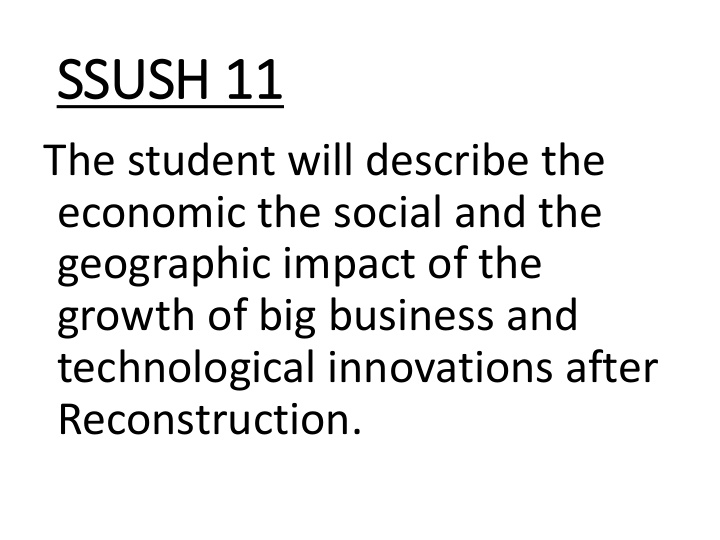



SSUSH 11 The student will describe the economic the social and the geographic impact of the growth of big business and technological innovations after Reconstruction.
In Industrialization and Urbanization Economic • New class of wealth – based on industry/big business rather than land • Rockefeller, Carnegie, Morgan – Captains of Industry or Robber Barons? Social • Gap between rich and poor grew along with the growth of a middle class based on wages rather than farm produce Geographic • Cities, urban areas became the centers of wealth production • Native American cultures decimated – Railroad brought westward expansion • Urban areas contain ethnic ghettos Eastern Cities – Southern/Eastern European Immigrants Western cities – Chinese and Mexican immigrants Big Business • From Railroad Industry sprang forth – Steel, Oil, Banking, Lumber, other industries Technological Innovation • Thomas Edison’s inventions – light bulb, movies, phonograph
SSUSH 11 a. Explain the impact of the Railroad Industry on other industries, such as Steel Industry , and on the organization of Big Business.
RAILROADS Time Zones are created because of Railroad, we set our clocks by railroad time! Steel Industry grows because steel needed to build railroads, trains, and eventually skyscrapers Other big businesses grow as a result of railroads Oil Industry grows - Lumber Because railroads provide - Cattle Means to transport oil from - Banking Western lands to Eastern -Western boom towns and cities arise as a result cities of railroads
Transcontinental Railroad Transcontinental railroad helped spur growth by: -increasing the number of markets (places to sell products). -requiring enormous amount raw and finished materials to build and supply the railroad. -providing land for settlement.
SSUSH 11 b. Identify John D. Rockefeller and the Standard Oil Company and the rise of trusts and monopolies.
Monopolies took several organization forms including what were known as trusts. Trust Stockholders of several competing corporations turn in their stock to trustees in exchange for a trust certificate entitling them to a dividend. Trustees ran the companies as if they were one. This political cartoon published The Verdict on July 10, 1899 by C. Gordon Moffat shows an America controlled by the trusts. To the public all monopolies were known simply as "trusts." These trusts has an enormous impact on the American economy. They became huge economic and political forces. They were able to manipulate price and quality without regard for the laws of supply and demand. Basic economic principles no longer applied They also had great political power. Trusts were extremely influential in Congress and in the Senate. Some even accused the trusts of "buying" votes. Although many Americans still regarded men like John D. Rockefeller as "Captains of Industry," more and more people began to publicly question the tactics of the "Robber Barons." As trusts grew ever more powerful and wealth became concentrated in fewer and fewer hands, animosity towards the new businessmen and the new methods of doing business increased tremendously.
John D. Rockefeller • Founded Standard Oil Company 1870 • Accused of unfair business practices • Vertically integrated Oil Business by buying businesses dealing with all aspects of oil production/refining, storing, producing • Gained monopoly = 90% of all oil produced by Standard Oil • Criticized by Ida Tarbell in series of articles and a book
BIG Business – Octopus = Standard Oil Cartoon Trusts and MONOPOLIES = Good or Bad?
BIG Business – Rockefeller Cartoon
The Steel Industry – Bessemer Process
RAGS TO RICHES The Steel Industry Mr. Andrew Carnegie – Robber Baron Extraordinaire
SSUSH 11 c. Describe the impact of the railroads in the development of the West; include the Transcontinental Railroad , and the use of Chinese laborers .
Abraham Lincoln signs law authorizing building of a Transcontinental Railroad during the Civil War RAILROADS • America connected East to West • Manifest Destiny realized • May 1869 at Promontory Point Utah – Union Pacific / Central Pacific unites and changes America forever
Transcontinental RAILROADS Famous pictures showing meeting of Central Pacific and Union Pacific uniting the Continent – May 1869 Promontory Point Utah
RAILROADS Railroad Construction: Chinese Labor Thousands immigrate to US to work on Railroads Dangerous work Low pay Discrimination In 1882, in response to the number of Chinese immigrants exceeding the number of European immigrants, the U.S. Government passed the Chinese Exclusion Act which halted Chinese immigration into to U.S. for 10 years & prohibited Chinese from becoming U.S citizens.
SSUSH 11 d. Describe the inventions of Thomas Edison ; include the electric light bulb , motion pictures , and the phonograph , and their impact on American life.
Thomas Edison…genius Phonograph:
Th Thomas omas Ed Edis ison on Inventions that changed America forever • Light Bulb – life and work = 24 hours nonstop • Phonograph – music industry created • Motion pictures – movie industry created • Founded Menlo Park – first research laboratory in America
QUESTIONS 1. How did the railroads help big business and the steel industry grow? 2. Why were railroads important in the settling of the west? 3. How was John Rockefeller able to control the oil industry? 4. What were the results on American life that many of Thomas Edison’s inventions had?
Recommend
More recommend